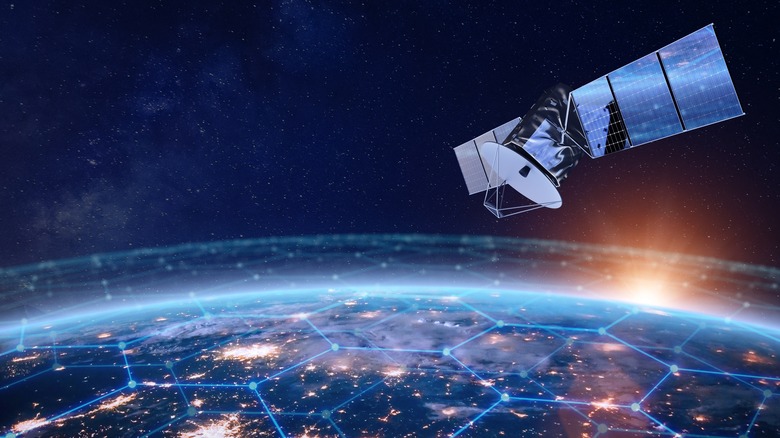Here's The Effects Space Radiation Has On Orbiting Satellites
Here on Earth, there are ever-present concerns related to the presence of radiation. Some have worried that we may be exposing ourselves to radiation from our many electronics, though thankfully, the vast majority of concerns about cell phone radiation are extremely overblown. However, radiation isn't purely a terrestrial concern — while it's mostly associated with things like atomic power and weaponry, radiation is a wholly natural force, existing both here on Earth and well beyond it.
Out in the darkness of space, there is ambient radiation emanating from all sides, whether it's from the Earth's magnetic field or the rays of the sun. Exposure to this kind of radiation is a concern for the brave individuals we send into the deep dark, but astronauts aren't the only thing space radiation could potentially affect. After all, orbiting the Earth is a belt of assorted commercial and research satellites, which spend a lot more time out in space getting a proverbial face-full of radiation than any human. Radiation may have less of an effect on the inorganic, but that doesn't mean that satellites are completely safe from detrimental effects, which could prove problematic for our networks later down the line.
Space radiation is a mixture of rays and particles from the Earth and beyond
Briefly, let's cover what space radiation actually is. As we mentioned, radiation is, broadly speaking, a natural occurrence. The majority of matter on Earth is stable, but some materials and electromagnetic waves either contain or produce unstable atoms, which break apart and release energy with unusual effects. These effects can be both benign and harmful; for instance, non-ionizing forms of radiation like visible light, radio waves, and microwaves carry energy, but not at a level that's harmful to humans, at least in the kind of small doses we're regularly subjected to. Ionizing radiation, on the other hand, is powerful enough to cause changes in molecular makeup, detaching electrons from atoms. This is the kind of radiation you have to be careful with, as it can induce atomic breakdown, killing cells and making you sick. In carefully controlled amounts, it can be used for practical purposes like x-rays, cancer treatment, and energy generation.
Even in the vacuum of space, where there's a whole lot of literally nothing, radiation can still take form, especially within the vicinity of terrestrial bodies like the Earth and the sun. In the Earth's orbit in particular, radiation can arise due to a combination of particles hiccuped out by the Earth's magnetic field, particles produced by intense solar flares from the sun, and even mysterious, unknown energies flying by from other celestial bodies somewhere in the universe. As stars live and die, firing off naked atoms in the process, energy is always flying by in space, meeting and mixing in strange, potentially hazardous ways.
Prolonged radiation exposure can damage a satellite's sensitive electronics
The effects of radiation on biological life are well-documented and generally unpleasant, to say the least. That's part of why space agencies take extra steps to protect their spacefaring staff from the effects of radiation with protective suits and space station materials. But there's nothing biological on a satellite, so surely, there's nothing to worry about in that department, right? Well, not quite.
While the inorganic materials that make up a satellite aren't as vulnerable to the presence of space radiation as a living person, all of that free-roaming energy can have dangerous effects, specifically on a satellite's delicate internal circuitry. Naked atoms are positively flush with electrical energy running amok, and as they pass through orbiting satellites, all of that energy passes through the electronic components. This can lead to sudden short-circuits, processor errors, and in the worst-case scenario, complete burn-out. Even outside of electrical problems, the constant bombardment of radioactive energy displaces the atoms that make up the circuitry, which leads to gradual degradation and failure.
Ironically, newer, more advanced satellites are actually more susceptible to damage from space radiation than older, simpler models. This is because more advanced satellites have smaller, more densely packed microprocessors. A little spark in the wrong place, and the whole thing can be fried. This is why manufacturers of satellites and satellite components have been developing additional protections, such as radiation detection systems and specially segmented processors, that won't damage each other in the event of a surge.


